How much Peeled, Sliced, or Chopped Artichokes are in a Pound?
Many recipes will call for "1 cup of chopped artichoke" or "1 pound of "peeled" artichokes" but it is not always easy to figure out actually how many artichokes are in a cup or in a pound. In order to help make cooking easier we did some experiments to help tell you exactly how many artichokes you need to buy.
The only edible portion of the artichoke petal or leaf is a small strip at the base where it connects to the heart or stem. The artichoke heart is the primary portion used in culinary dishes; it is often used sliced, chopped or whole. A peeled artichoke commonly refers to one that has all of the tasty consumable parts remaining; all non-edible portions have been removed.
To answer How many artichokes in a cup we went to the grocery store to check out the vegetable section. We discovered they come in various sizes and can weigh between 5 ounces to over 2 pounds, with the majority of artichokes we checked in this store coming in about 14 to 16 ounces. After surveying the selection we concluded that 1 pound would be the best measurement for our how many artichokes in a cup testing samples.
We found that once "peeled" a 1 pound artichoke yields about 1.25 to 1.5 cups which include internal leaves or bracts), heart and stem interior. It takes 6 fresh artichokes to yield enough hearts to equal what you get in an 8 ounce jar. This process leaves a lot of waste product to throw away!
Did you know that an artichoke is really an unopened flower blossom of a large plant in the thistle family that originated in the Mediterranean region. The U.S. artichoke crop is only produced in and around Castroville, California. In 1947 Marilyn Monroe, then still going by her birth name of Norma Jean, was crowned Castroville's first Artichoke Queen. And finally, the artichoke has such a potent effect on the taste buds that most people find a lingering sweet taste after eating it. In fact anything eaten shortly afterwards takes on that same sweet taste. So beware, you may want to skip having an expensive bottle of wine with this dinner!
Next time your recipe calls for a cup of chopped or peeled artichokes you'll feel confident knowing how many you need. You can also use our conversion tool below for any custom how many artichokes in a... measurements you need.
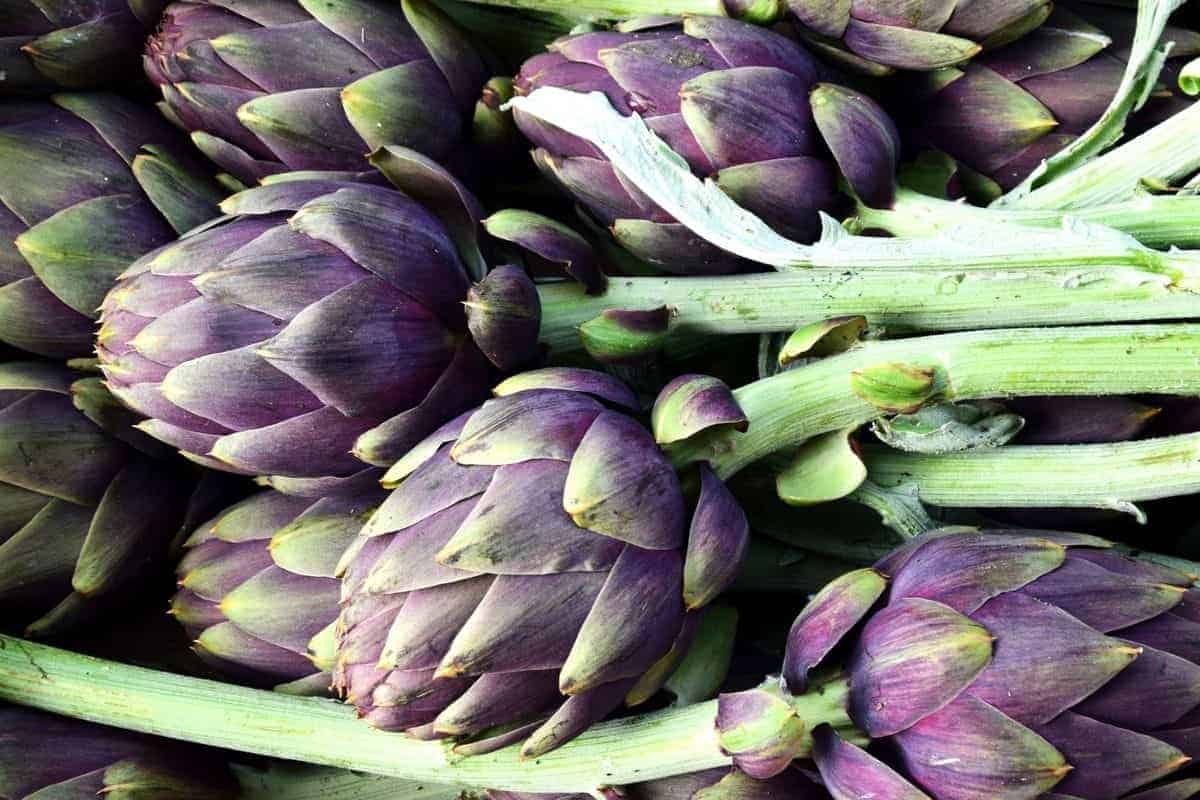
Custom Conversions for Pound of Artichokes
One Pound of Artichokes Equals
- There is 2/3 Cup (158 mls) of Chopped Peeled Artichoke in a Pound of Artichokes
- There is 2/3 Cup (158 mls) of Sliced Peeled Artichoke in a Pound of Artichokes
- There is 14 Ounces (397 mls) of Artichokes in a Pound of Artichokes
of
You need 1.5 Pounds of Artichokes
Want a Fancy Cocktail?
How Much Is In a Pound of Artichokes?
A whole artichoke can weigh anywhere between 5 ounces to 2 pounds or 140g to over 900g, depending on its variety and size. And a medium globe artichoke comes in about 14 to 16 ounces (400 to 450 grams).
We found that once "peeled" 1 pound of artichoke yields about 1.25 to 1.5 cups of edible food.
A peeled artichoke only includes the bottom of the internal leaves (or bracts), heart and stem interior. All of the non-edible portions have been discarded.

How Many Cups of Cubes are in a Chopped Peeled Artichoke?
Due to the low percentage of an artichoke that is actually edible, it’s difficult to determine the quantity of cubes that can be cut. In addition, the bottom part of the artichoke leaves is not chopped with a knife, but instead this flesh is scraped out with your teeth and chewed.
Each whole artichoke only has one heart and one stem interior to be “chopped into cubes”. So, with 1 whole artichoke, you can probably get about ½ to ¾ cup of chopped heart and stem.
How Many Whole Artichokes are Needed for a Cup of Artichoke Hearts?
Depending on how cleanly the heart gets removed, it takes 4 to 6 whole artichoke hearts in order to yield 1 cup. This cup of hearts weighs about 6 ounces or 170 grams.
Since an artichoke is a time consuming vegetable to trim or peel, many folks prefer to buy the hearts in either a can or jar. You can purchase whole, chopped or sliced artichoke hearts in an 8 ounce (227 g) jar at the grocery store. You can even find artichoke hearts either marinated or in a plain liquid.
How Many Cups of Slices are in a Peeled Artichoke?
As with cubed artichoke, the low percentage of edible flesh that can be sliced is small per artichoke. The very bottom portion of an artichoke leaf is edible, but it is pulled out with your teeth and eaten.
Each whole artichoke only has one heart and one stem interior that can be "sliced". So, with each whole one, you can probably get about 1/2 to 3/4 cup of sliced artichoke heart and stem.

What Is an Artichoke
An artichoke is an odd looking flower bud from a thistle. Its plant is a member of the aster family. If the bud is left on the plant to mature, it will bloom into large fragrant thistle type flowers that are pink or purple in color.
Whether you are just eating the hearts, the stems' interiors or the leaves (called bracts) by dipping them in a sauce or just melted butter, it takes a lot of work to get there. Some folks don't think it's worth the effort for such a small amount of fresh edible flesh. But there is a large group who don't mind the work for the delicious tender prize.
For those not up to the fresh challenge, artichoke hearts are sold in a can or jar in the grocery store. You can readily find them in a plain liquid, marinated, whole, or quartered.
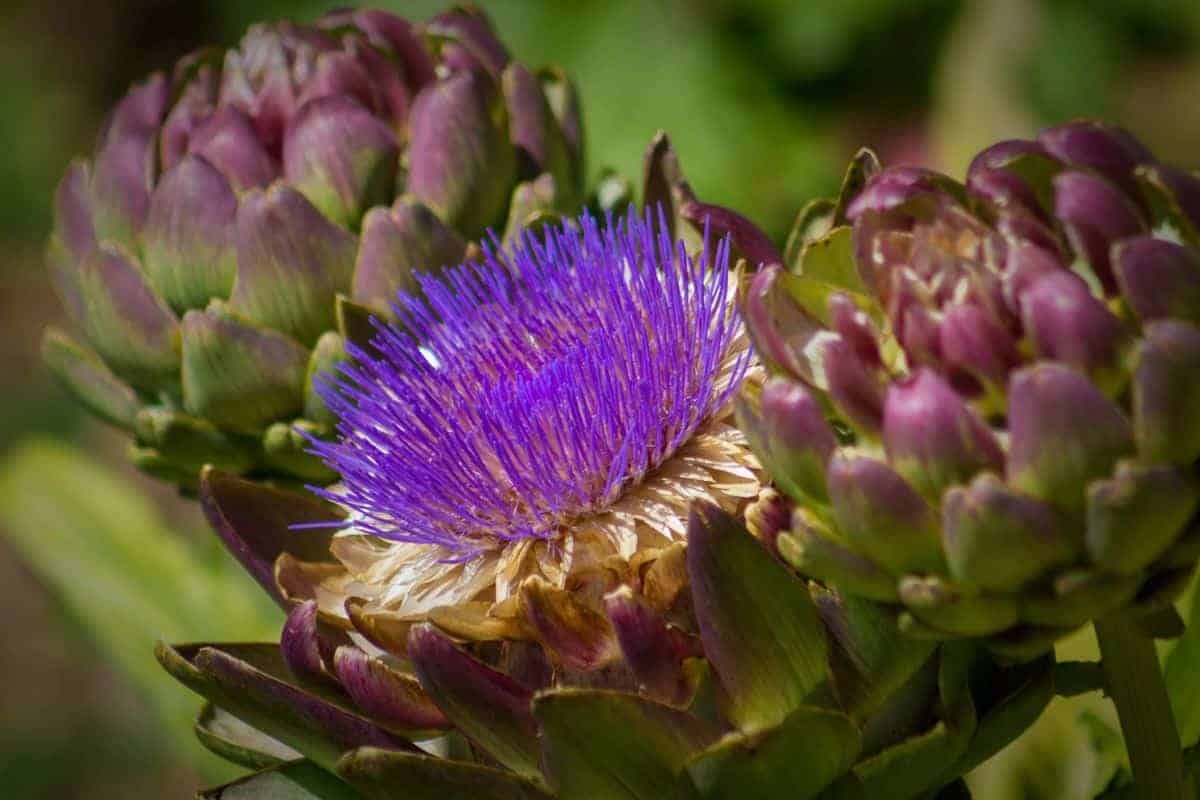
Is Artichoke a Fruit or Vegetable?
Artichoke is a vegetable even though the plant bud can bloom if left alone. However, these flower buds are eaten before they are pollinated, matured and grew seeds.
Fruit is a fully grown and pollinated flower that produces seeds inside it. We basically only eat the part that holds the seeds.
What Are the Types of Artichokes?
What is a Jerusalem Artichoke?
Jerusalem artichokes actually are not related to artichokes. They are a vegetable which is a member of the sunflower family. When uncooked, the white flesh is nutty, sweet and crunchy like water chestnuts.
What Does an Artichoke Look and Taste Like?
An artichoke plant grows from 4 1/2 to 7 feet tall with long silvery-green leaves. The artichoke itself looks like a dusty green flower bud that never opened.
Artichokes are normally cooked before eaten, giving them a soft texture with a mild nutty taste. Smaller artichokes are more tender than ones grown to a larger size.
People tend to compare the taste of an artichoke to asparagus, broccoli stems, salsify and brussels sprouts.
Artichokes can be eaten raw, but they have a bitter taste and lack the tender texture.
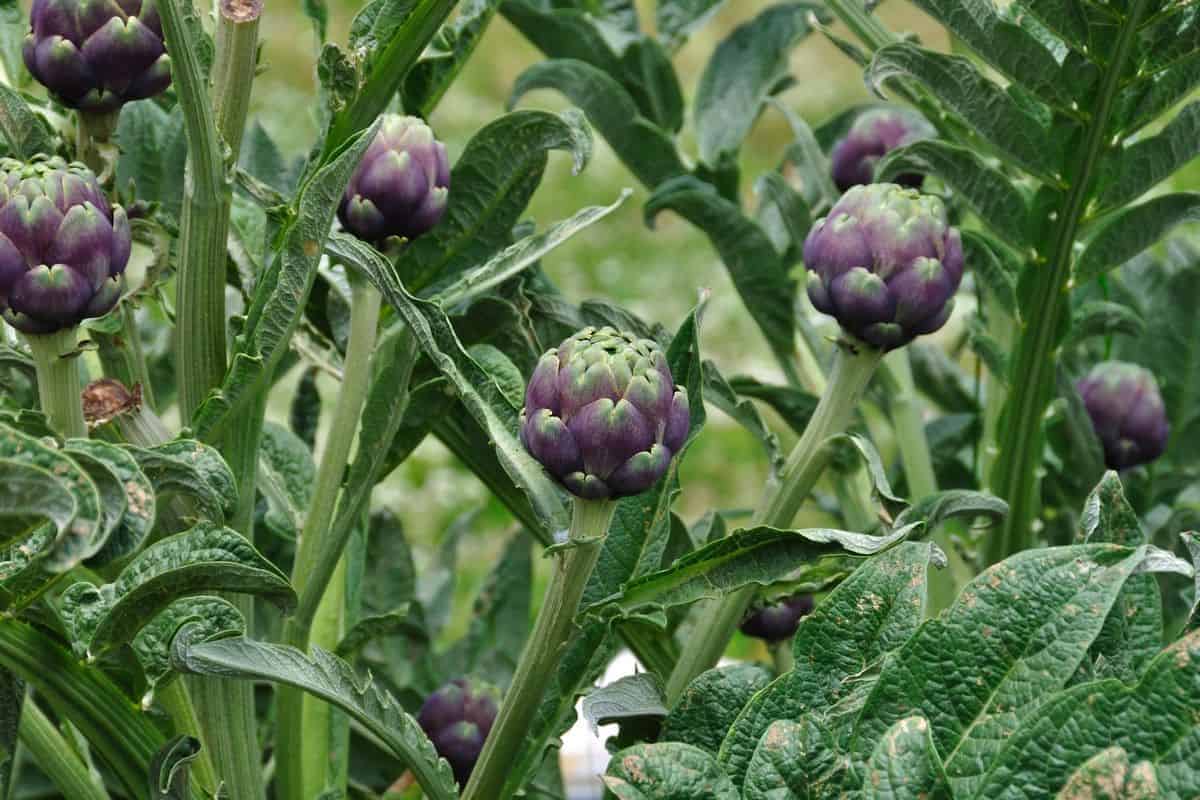
What Is Artichoke Good For and Used In?
What are Good Substitutes for Artichoke Hearts?
In a pinch, you can always use canned or frozen interchangeably. You could even use marinated artichokes but it would alter the flavor profile of your dish.
If you want to use a fresh alternative, several good options are Jerusalem artichokes, Brussel sprouts, or palm hearts. Some less easily found ones are cardone and chayote.
Can I Feed Artichoke to My Dog, Cat, or Other Pet?
People seem to agree that dogs can eat artichokes raw or cooked. In addition to the hearts, dogs seem to be able to tolerate the artichoke leaves, where people cannot.
You may want to avoid a choking hazard by chopping up and cooking the artichoke instead of giving your pet a large hunk.
When feeding your pet unusual foods, it’s best to start in moderation to be sure your individual pet can handle it.
Does Artichoke Give You Gas?
Yes, an artichoke is a vegetable that is high in fructans, a complex sugar that is more difficult to digest. In addition to gas, these types of food can cause stomach pain and bloating.
How to Store Artichoke
It's best to use a fresh artichoke the same day you purchase or pick it. But if that isn't possible, you have several storage options depending on how long until you plan to use the artichoke. Artichokes can be put on the counter, in the refrigerator or in the freezer.
Cooked artichokes can be stored in an airtight container in the refrigerator for a few days.
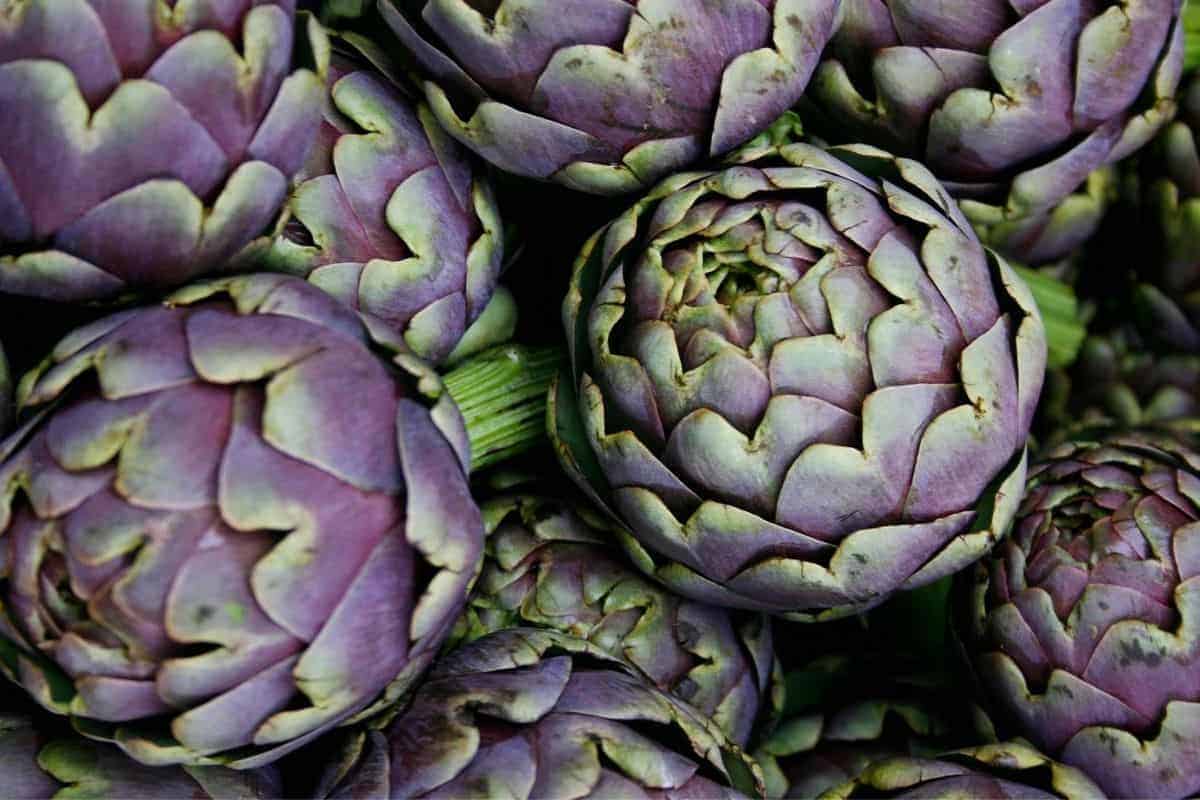
How Long Does Fresh Artichoke Last at Room temperature?
Artichokes need to be kept cool until used. If you are planning on using it the same day you purchased or picked it, storing the artichoke on the kitchen counter is just fine.
If you aren’t using it until the next day or longer, storing the fresh artichoke in the refrigerator will work better.
How to Store Artichoke in the Refrigerator
It’s best to use an artichoke the same day you purchase or pick it. But if that isn’t possible, you can store it unwashed in the refrigerator for 4 to 5 days to help maintain its freshness.
Some of your refrigerator storage options for a whole fresh artichoke are:
Simply place the artichoke in a plastic bag. Or
If the stem is still attached, you can cut a thin slice off the bottom of it. Then spritz the cut location on the stem with some water and place it in the plastic bag. Other than the bottom of the stem, the rest of the artichoke is not moistened. Or
Another common method is to prop the artichoke up in a container so only the bottom of the stem is standing in a small amount of water. Cover the artichoke and container with a loose plastic bag.
Once artichokes are cooked, they can be stored in an airtight container in the refrigerator for about 5 days.
Can You Freeze Artichoke and if so How?
Yes, freezing artichokes is a great way to preserve them for use later on. However, they will need to be trimmed and blanched before you freeze them or your bounty will turn bitter and look brown.
After washing the vegetables, trim 1" to 2" off the crown and snip off the thorny ends of the leaves. Place the artichokes in a large pot of softly boiling lemon water and blanche for about 20 minutes.
Remove the artichokes with a slotted spoon and place them leaves-down-stems-up on a drying rack. Once they have dried completely, place the vegetables on a tray and put them into the freezer without covering.
Once frozen, place the artichokes into Ziploc freezer bags and store in the freezer. These will remain tasty for 6 to 8 months.

How to Cut Artichoke
Due to the odd shape and tough outer leaves called bracts, a whole artichoke is not “cut” in the normal sense, it’s more trimmed or prepared. Once removed from the vegetable, only the artichoke heart and interior of the stem can be chopped, sliced, cubed, etc.
For an excellent in depth step-through guide on artichokes, check out the How to Clean, Trim, and Prepare Artichokes by Serious Eats
How to Prepare an Artichoke
Most varieties of artichokes have little thorns on the ends of their "leaves" (actually called bracts). These can either be left on to soften during cooking or the sharp ends snipped off with kitchen scissors. Sometimes the thorns can become bothersome during the rinsing process. For a fancier plate presentation, the tips are usually removed.
With a serrated knife, slice about 1" off the top of the artichoke. Then remove all the small or tougher leaves or bracts on the stem at the base.
Trim off the stem leaving 1" to 1 1/2" on the artichoke. Using a paring knife, skin the tough outer surface off of the stem.

How to Clean an Artichoke
With your hands, rinse the artichokes under cold running water by separating the leaves (bracts) a little bit so any dirt is removed from in between.
Can I Eat the Skin of an Artichoke or Should I Peel It First?
The outer portion of the leaves or bracts are not eaten raw or cooked, neither is the hairy choke that sits above the delicious heart of the artichoke.
In addition to the heart and the inside of the stem, only the very bottom of the inside of the inner bracts are eaten. This is where the bracts or leaves are attached to the heart and a little bit of its edible flesh can be found.

How to Slice an Artichoke Heart
Sometimes you need sliced artichoke hearts for a dish you’re making. If so, slicing is a general term that means to cut across the food into thin, uniform pieces. Slices are normally between 1/16” and 3/8” thick and not squared off on the ends unless you are doing a special preparation.
Place the trimmed and cleaned artichoke heart on a cutting board. With a paring knife, cut the heart into uniformly thin pieces either lengthwise or crosswise depending on the look you are going for.
Now you either have a stack of longer slices or a stack of shorter slices for your recipe.
How to Chop an Artichoke Heart
Some recipes use small chopped pieces of artichoke hearts. In this case it is referring to an imprecise bite-sized piece where uniformity and shape are not important.
With the trimmed and cleaned up artichoke heart on a cutting board, use a paring knife to quickly cut it into lengthwise strips, without worrying about the consistency of the cut.
Place the flat side of the stack of slices down on the cutting board and once again make lengthwise slices. You now have a stack of sticks with varying widths.
Turn the sticks 90 degrees and slice across the heart sticks, making them into chopped pieces.

How to Dice or Mince an Artichoke Heart
When diced or minced artichoke heart is called for in a recipe, it is generally referring to a cube shaped piece of a certain size. A diced cut makes a little bit larger piece than a finely minced one, but both are uniform sized squares.
The cut size recommended for your vegetable in a recipe makes a difference. It affects not only how long they cook, but also the general texture, taste and appearance of the final dish.
Place the trimmed and cleaned artichoke heart on a cutting board. With a paring knife, cut the heart lengthwise into the width of slices you want. Next place the stack of slices flat side down on the cutting board and once again make evenly spaced slices down both halves. Now you have a stack of uniformly cut sticks.
Turn the sticks 90 degrees and repeat making slices across the same width as before. You now have a pile of evenly cut diced artichoke hearts.
How to Mash or Puree an Artichoke Heart
Some folks enjoy artichoke hearts mashed with potatoes for variety and a nuttier flavor profile.
The can of hearts (or if you prefer fresh hearts that are cooked) are pureed with the herbs, spices and milk that will be mixed into the mashed potatoes.
Once the cooked potatoes are mashed with the butter, the pureed milk mixture is thoroughly mixed in. These mashed potatoes are now ready to serve.
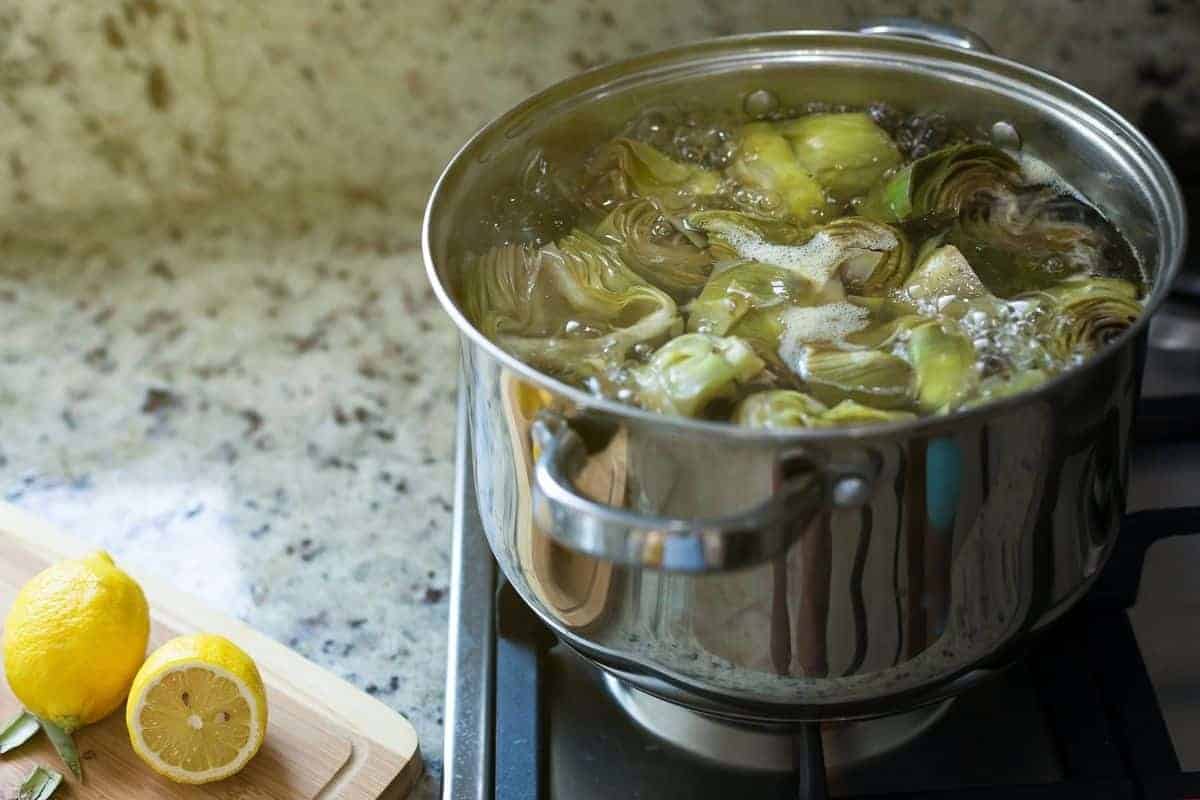
How to Make Artichoke Heart Juice
Because of the small size of an artichoke heart, it would take quite a few to make a reasonable quantity of juice. It definitely can be done, but it doesn’t seem to be recommended very often. When it is included in a recipe, it seems to be a very small amount added to the juice of other fruits and vegetables that are easier to prepare and cheaper to buy.
The artichoke hearts would be placed in the electric juicer or in a blender along with the other ingredients and run.
How to Cook a Artichoke
A popular, simple and foolproof way to prepare whole artichokes is to steam them in a pot on your cooktop. Since they are ready to serve when the leaves easily pull off of the artichoke, you can quickly monitor their doneness.
The actual cooking time depends on the size and density of your artichoke but for steaming it takes around 25 to 35 minutes.
If you're short on time, you can use a pressure cooker but it is more difficult to tell when they are finished. This cooking technique can take anywhere from 5 to 15 minutes under high pressure.
In addition to steaming, recipes also include sauteing, braising, baking stuffed, boiling, grilling, microwaving, etc. It's important to not let the artichokes dry out during whatever cooking process you use or the leaves or bracts become tougher. However, boiling artichokes tend to make them a bit waterlogged.
Cooked artichoke hearts can be served with a sauce as a side dish or in a cold salad or an appetizer dip. Most people eat cooked artichokes but they can be eaten raw.

How to Eat an Artichoke
The very bottom of the inner leaves or bracts, the heart, and the inside of the stem are the edible parts. When steamed whole, it can be a culinary adventure to consume an artichoke.
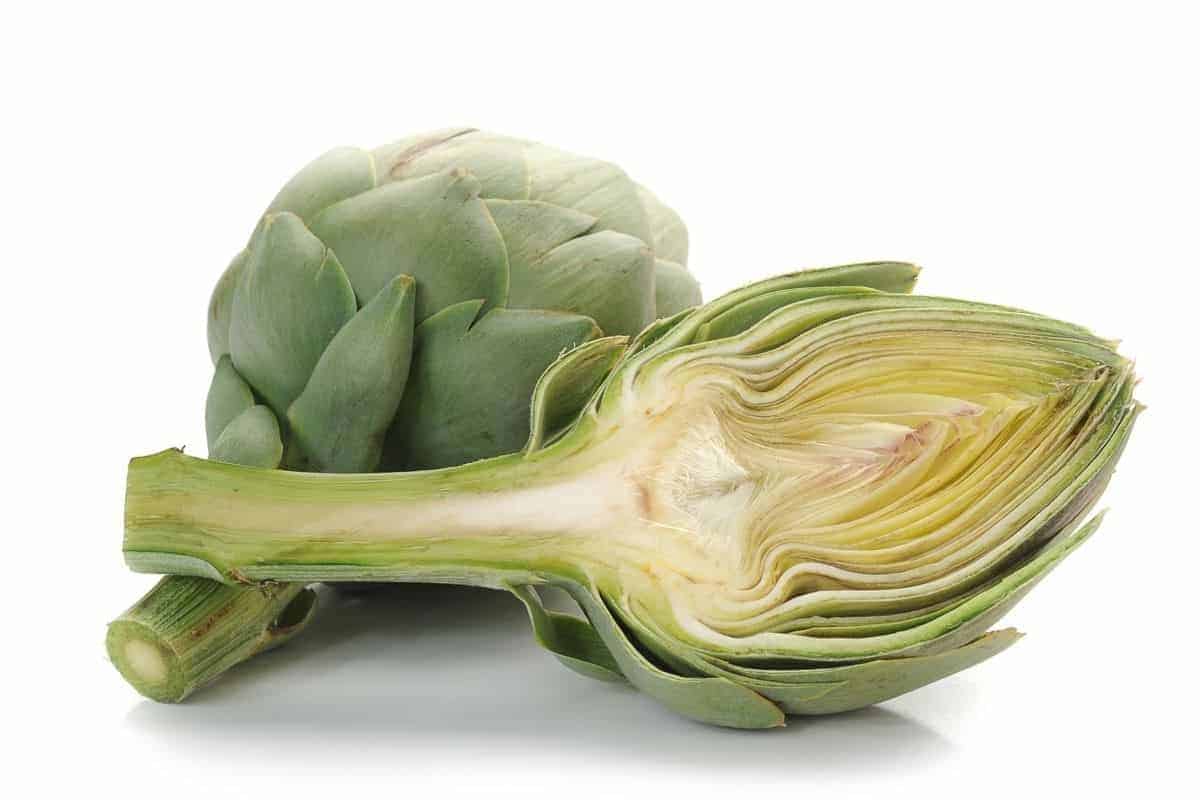
Most likely the artichoke will be accompanied by a small dish of sauce or melted butter for dipping. The artichoke will be served to you whole, sitting up in a bowl with the green leaves or bracts sticking up.
To begin, pull out one leaf and dip the white pulp end into the sauce. Put that end into your mouth, bite down and pull the leaf back out of your mouth through your clenched teeth.
This allows you to get the small piece of tasty heart that resides at the end of each bract. Set aside the rest of the leaf to be thrown away later. Repeat the process on the next leaf until you have enjoyed them all.
Next scoop out all the hairy choke with a spoon - this will be thrown away.
Now the prized tender heart of the artichoke will be exposed with the fibrous skinned stem attached beneath. Using a paring knife remove the outer skin from the stem to unearth more tender flesh.
The delicious flesh of the artichoke heart and interior stem can just be cut up into pieces, dipped in the sauce and eaten with a fork like "normal" food.
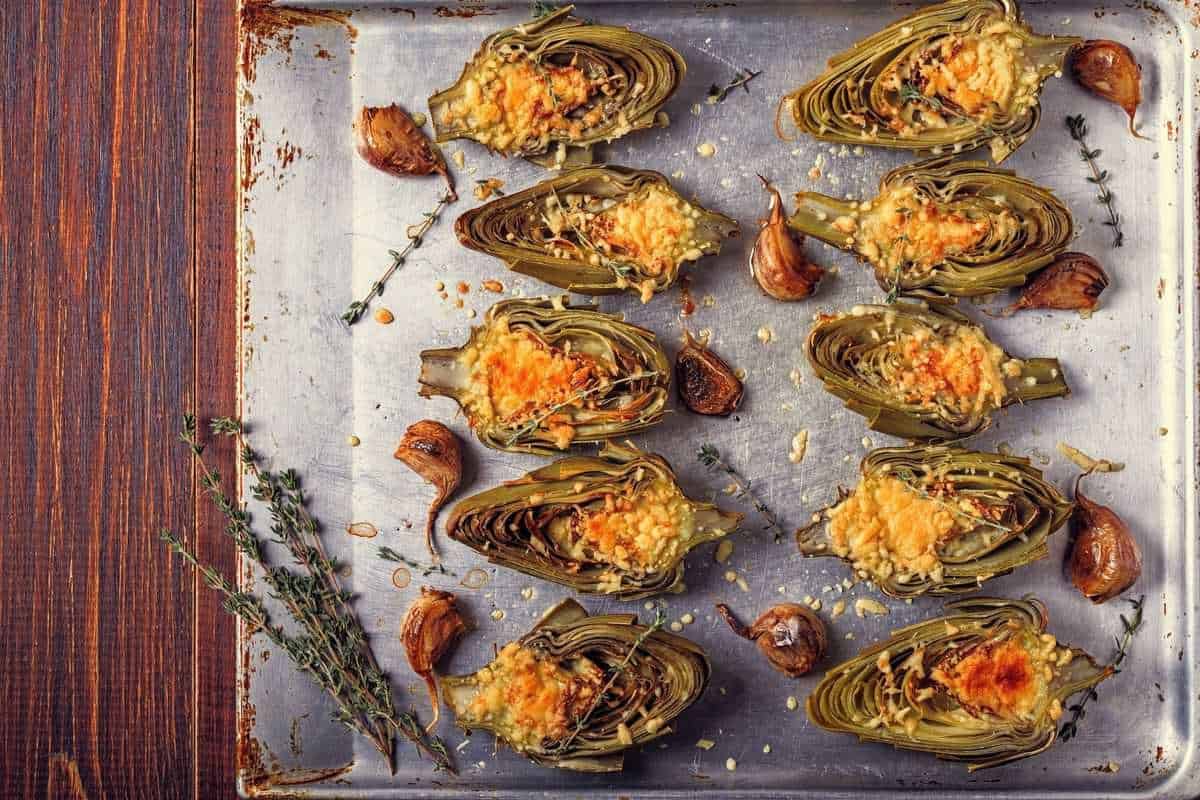
How to Steam an Artichoke
If you don’t have access to an actual steamer pot, and you’re not ready to purchase one, all you need is a large pot, something to hold the vegetable out of the 1” to 2” of water and a lid.
Put a couple inches of water into the pot with the steaming basket in place, making sure the water is low enough. Place the artichoke into the basket and put on the lid.
Bring the pot to a boil and reduce the heat to a simmer and cook until the outer leaves easily pull off from the artichoke. Depending on the size of the vegetable, it will take about 25 to 35 minutes.
How Can I Tell If an Artichoke Is Ripe?
When shopping for a ripe artichoke, look for one with tightly packed leaves, not loosely separated from one another. Major bruises or brown tipped leaves are not a good sign.
As with many fruits and vegetables, fresher ones tend to have a higher moisture content so they feel heavier for their size. Older, dried out produce feels lighter.
Squeeze an artichoke’s leaves with your fingers, if it is really fresh and crisp, you will hear a squeak.
A ripe artichoke normally is a dusty green color which turns olive green when cooked.
When possible select ones with 1” to 2” stems still attached.
Even though artichokes are available year round, selecting Most abundant March to June
Is Artichoke Keto Friendly?
Basically a keto diet consists of eating high fat, moderate protein and very low carb foods. Some medical professionals feel a keto diet is not safe for a person with pre-existing medical conditions or as a long-term option.
So yes, artichokes are regularly eaten on Keto diets because they are a low carb food that also provides a little protein. In addition, they provide a good amount of dietary fiber and many other beneficial nutrients.

Is Artichoke Low FODMAP?
Food is a common trigger of digestive warning signs. FODMAP is concerned with groups of fermentable carbs (or sugars) that often trigger digestive symptoms like bloating, gas, diarrhea and stomach pain.
A diet low in FODMAPs is often prescribed to help manage abdominal issues in sensitive folks and to help figure out which foods are causing the issues.
Globe artichokes are allowed on a low FODMAP diet but with a lower portion size.
Jerusalem artichokes, which are not really an artichoke, are NOT considered a low FODMAP food at all.
- How Much Is In a Pound of Artichokes?
- How Many Cups of Cubes are in a Chopped Peeled Artichoke?
- How Many Whole Artichokes are Needed for a Cup of Artichoke Hearts?
- How Many Cups of Slices are in a Peeled Artichoke?
- What Is an Artichoke
- Is Artichoke a Fruit or Vegetable?
- What Are the Types of Artichokes?
- What is a Jerusalem Artichoke?
- What Does an Artichoke Look and Taste Like?
- What Is Artichoke Good For and Used In?
- What are Good Substitutes for Artichoke Hearts?
- Can I Feed Artichoke to My Dog, Cat, or Other Pet?
- Does Artichoke Give You Gas?
- How to Store Artichoke
- How Long Does Fresh Artichoke Last at Room temperature?
- How to Store Artichoke in the Refrigerator
- Can You Freeze Artichoke and if so How?
- How to Cut Artichoke
- How to Prepare an Artichoke
- How to Clean an Artichoke
- Can I Eat the Skin of an Artichoke or Should I Peel It First?
- How to Slice an Artichoke Heart
- How to Chop an Artichoke Heart
- How to Dice or Mince an Artichoke Heart
- How to Mash or Puree an Artichoke Heart
- How to Make Artichoke Heart Juice
- How to Cook a Artichoke
- How to Eat an Artichoke
- How to Steam an Artichoke
- How Can I Tell If an Artichoke Is Ripe?
- Is Artichoke Keto Friendly?
- Is Artichoke Low FODMAP?
How to Store Pound of Artichokes
General How to Store Artichoke Info
Starting with the freshest artichokes will lengthen its shelf life and help maintain good flavor. Select ones that are heavy and firm with a compact center, and sporting a healthy green color.
Short Term Artichoke Storage
Store fresh unwashed artichokes in a plastic bag in the crisper section of the refrigerator for 1 week.
Cooked artichokes can be refrigerated in a sealed container for up to 4 days.
Long Term Artichoke Storage
To freeze whole cooked artichokes: Blanch artichokes in a mixture of 1/2 cup lemon juice or 1 tablespoon ascorbic acid (Vitamin C) to 2 quarts of water to keep the globes from darkening. Blanch small artichokes for 3 to 5 minutes and medium for 7 minutes. Drain completely, wrap tightly in foil and pack in plastic freezer bags or other airtight containers for 6 to 8 months.
Do not freeze or can raw artichokes: freezing turns the flesh black and destroys texture and flavor; canning turns artichokes mushy.
Artichokes can be pickled.
Artichoke Side Notes
The artichoke is a member of the thistle group of the sunflower family.
Pound of Artichokes Recipes
Sous Vide Navy Bean & Artichoke Salad with Mint Dressing and Fried Alliums Recipe
 While it sounds complicated, this recipe utilizes a very simple technique of layering flavors and textures to create a delicious and flavorful final dish.
While it sounds complicated, this recipe utilizes a very simple technique of layering flavors and textures to create a delicious and flavorful final dish.
Sous Vide Artichokes Recipe
 While the look daunting, once you learn how to trim them, artichokes can be simple and quick to prepare. The key is to use lemon on them throughout the cutting process to prevent oxidation. These are great added to a salad or pasta dish.
While the look daunting, once you learn how to trim them, artichokes can be simple and quick to prepare. The key is to use lemon on them throughout the cutting process to prevent oxidation. These are great added to a salad or pasta dish.
Looking for Something a Little Different?
Popular Vegetable Conversions
How Many Bananas in a CupHow Much is a Bunch of Sage
How Much Juice in a Lime
How Much is a Bunch of Thyme
Volume of an Egg
How Much Corn is on an Ear
How Many Bread Crumbs in a Slice of Bread
How Much Is A Bunch Of Cilantro
How Much Is In A Bunch Of Basil
How Much Shredded, Sliced, Or Chopped Is In A Carrot
How Much Is A Pound Of Cheese Cubed Or Shredded
What is the Produce Converter?
One of the biggest hassles when cooking and working in the kitchen is when a recipe calls for "the juice of 1 lime" or a similar measurement. Often times when cooking people use bottled juices, pre-sliced vegetables and other convenient cooking time savers. Produce Converter will help you convert the "juice of 1 lime" and other similar recipe instructions into tablespoons, cups and other concrete measurements.
Produce Converter can also be used to figure out how many vegetables to buy when you need, for instance, "A cup of diced onion." You can use our easy conversion tool to figure out exactly how many onions you need to buy at the store in order to end up with the amount you need for your cooking.
We hope you enjoy Produce Converter and if you have any suggestions for how we can improve it and make your cooking easier please let us know.









